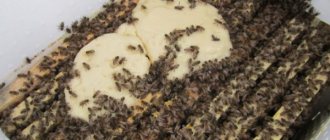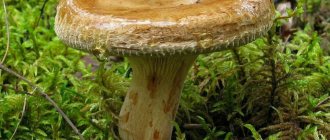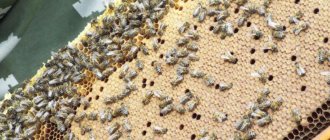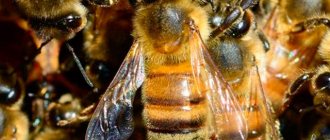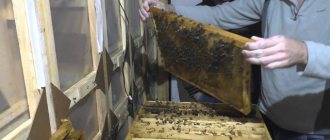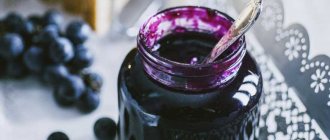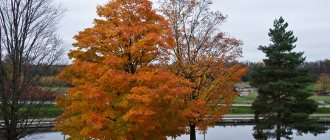Rules for feeding bees
The beekeeper faces two main tasks:
- To provide bee colonies with conditions for normal life and to prevent pathology in the development of bees.
- Obtain a high yield of beekeeping products. This can only be achieved if the basic condition is met: insects must receive nutrients in the required quantities.
To do this, bee colonies need to provide three conditions:
1. Spring bribe should help the development of viable and strong bees.
2. The main bribe must be long-term and significant in volume so that the bees can effectively use it to obtain beekeeping products.
3. The autumn bribe should be aimed at strengthening and developing the strength of the bee colony.
Features of autumn-winter feeding
If there is not enough natural honey to feed bee colonies, then the bees should be fed with sugar syrup for the winter. The rules for its implementation regulate certain time frames:
1. In August, you should start feeding bees with sugar syrup for the winter. Proportions in sugar syrup: per 1 kilogram of sugar - 1.5 liters of water. Portion for daily use – up to 300 grams per hive. This syrup is intended for old bees, which, having processed it, will die over the winter.
2. Nests for wintering should be ready by September. If bee colonies by this time still need food, then the concentration of syrup should be increased. In such cases, the bees are fed with sugar syrup for the winter as follows: 3 to 2 – the ratio of sugar and water. The amount of feed also increases: the daily dose is up to three liters. This is necessary to quickly fill the cells.
3. Winter nutrition consists of regular feeding with honey or sugar syrup in a very small concentration. Daily dose – 15-30 grams.
4. When wintering comes to an end, warm syrup is poured into the honeycombs of one frame and the frame is placed in the hive, from where the empty honeycombs are first removed. Then you need to re-insulate the hive.
Recipes
You will need:
- 12 liters of water, 14 kg of sugar, 28 grams of citric acid - for spring feeding;
- 5 liters of water, 8 kg of sugar, 15 grams of acid - for preparing winter food.
Stages of making fudge:
- Boil the water. It shouldn't be tough.
- Pour it into a container with sugar. Use natural sugar without additives for this purpose.
- Stir the mixture until the sugar is completely dissolved.
- Cool the solution. As soon as the temperature drops to 45 degrees, you can add additives.
- Pack the food into plastic bags and place it on top of the hive.
How to determine the quality of honey? Add the sweet thick mass to the quicklime. If flakes form in the sweet thick mass, then it is not suitable for feeding bees with honey.
Feeding bees in autumn
Autumn. Bee houses heading for the winter require replenishment of food supplies, because ahead is a low-active and very difficult period for bee colonies - winter, with all its treachery and mercilessness. In order for the bees to successfully survive it, to be ready to produce viable offspring in the spring and to produce beekeeping products, they must be carefully and timely prepared for the winter period.
Feeding bees with sugar syrup for the winter helps solve several problems:
- prepare the necessary food supplies if the bee colonies are unable to cope with this task themselves;
- reimburse honey that was withdrawn at the end of the main honey harvest;
- replace honey with rapid crystallization and honeydew honey with high-quality syrup;
- feed the bees with therapeutic and prophylactic agents, if necessary.
For effective wintering, the best food is natural honey, preferably flower honey. But it’s not always possible to leave it for the bees. In this case, you have to decide how to feed the bees with sugar syrup.
What additives can be used in syrup for bees: 3 types
Various drugs are added to the syrup to prevent diseases and strengthen bee colonies. For example, in August, 20 mg of fumagilin is added per 1 liter of feeding - this is a good way to prevent nosematosis.
Be sure to read:
Caring for bees for beginners: tips, processing rules, how to care all year round
To invert a sugar solution, 3 types of substances are used:
- organic acids (citric, lactic, acetic);
- honey (candied or unripe can be used);
- “Pchelit” is an enzyme-yeast preparation.
How to make syrup?
It is very important in the autumn to prevent severe wear and tear on the bees; it is important to preserve the energy with which insects break down polysaccharides and seal the honeycombs. They must complete the necessary work as quickly as possible. In this process, they need the help of a beekeeper - they need to ensure that the bees are fed with sugar syrup for the winter; it is advisable to use the following proportions: sugar 3 kg, water 2 liters. This will give a solution that is most convenient for processing by bee colonies - 64%.
One of the options for making syrup:
- You need to take sugar, definitely light sugar.
- Pour water into a clean container and bring to a boil.
- Pour sugar into boiling water and, stirring, dissolve it.
- You can (but do not have to) bring the syrup to a boil and immediately remove from heat. It is contraindicated to boil the syrup, because if the sugar burns, it will become unsuitable for bees.
- Cool the syrup to 30 degrees and distribute to the bees. Bee colonies will be reluctant to take cold syrup.
There are important points in the syrup preparation process that you need to pay attention to:
- It is recommended to use soft water. The fact is that in hard water the rate of syrup crystallization increases. If hard water is used as a basis, then first it must be settled and only after that the process of preparing the syrup begins.
- In order to bring the sugar syrup closer to the acidic reaction characteristic of flower honey, it is necessary to pour acetic acid (70%) into the syrup in the proportion of 0.3 grams per kilogram of sugar. This proportion will bring additional benefit - it will provide a preventive effect against nosematosis.
Why don't bees take syrup?
Beekeepers often notice that some families ignore feeding. There are several possible reasons why bees do not take syrup:
- Insects are weakened or sick. In such cases, they are sprayed with medicinal solutions using spray bottles.
- The solution turned out to be too thick or thin.
- It's too cold outside.
If the bees do not take food after eliminating possible causes, it can be replaced with honey.
Proper preparation and supply of fertilizing in the spring is the key to high productivity of honey-bearing workers in the summer and the quality of the resulting product.
The amount of feed is the key to successful wintering
The bee colony must be provided with food in such quantities that will enable each bee to successfully overwinter. But it is not always possible to correctly calculate the amount of feed required for this. In such a situation, a convenient way out is to provide food in large quantities. If the food is not used in full, it can be used for the spring development of the bee colony.
It should be noted that when feeding bees with sugar syrup for the winter, it is necessary to calculate the proportions of food for a specific bee colony, taking into account certain factors:
- in which region is the apiary located: in the south there is a shorter winter, therefore, in such regions in the south, less food reserves are needed;
- whether wintering takes place on the street or in a winter hut: if bees winter on the street, then they need more food than during wintering in an omshanik;
- family strength: a family that winters, for example, on eight frames, needs much more carbohydrate reserves than a family that spends the winter on five frames.
The frames that are installed in the nest for wintering must contain food in an amount of over two kilograms with a total amount of food product of 9-15 kilograms. Some beekeepers, giving recommendations on how to ensure that bees are fed with sugar syrup for the winter, advise increasing food supplies to 30 kg.
In order to process sugar syrup, bees spend large amounts of energy, so part of the food is used to restore the expended energy. Because of this, not all of the processed syrup ends up in the honeycombs. This should also be taken into account when answering the question of how to feed bees with sugar syrup for the winter.
Honey is full
Another autumn recipe: honey full. To prepare it, boil water, cool it to 50ᵒC and add one kilogram of honey to one liter of water. If necessary, stimulants and medicinal substances are added.
Prepared fertilizers must be fresh. To ensure that the preparation of autumn feeding of bees is not unnecessary, the calculation is made on the family.
I already wrote how to correctly calculate the required amount in an article about winter feeding.
Some beekeepers do not calculate the dose too much and store the remaining syrup in the refrigerator.
When to fertilize?
Beginning beekeepers are often concerned about the question of when to start feeding bees with sugar syrup for the winter. The deadline for completing the process must be unchanged - no later than September 10, the beginning of the process is August, this period is regulated by the time of the end of the main bribe and the end of pumping out honey.
This is explained by the fact that bees wear out during syrup processing. As a result of this, those insects that process it will not be able to survive until spring. Only young bees that were in the brood stage in the fall will survive the winter.
If the feeding process continues throughout September, two serious problems may arise:
1) Young bees will join the syrup processing process; they will also wear out during feed processing and will not survive the winter.
2) If syrup-nectar flows into the nest for a long time, the queen will perceive this as a signal that the bribe continues, and she will worm, that is, lay eggs for a long time. The newly emerged bees, due to the established cold weather, will not have time to make their first flight, as they will emerge from the brood late. They will leave feces in the hive, and the bees will not take honey from these honeycombs. In addition, this can lead to the appearance of nosematosis.
The result will be disastrous - the family will die.
If everything is done correctly, then at the moment when there is enough food and the nectar stops flowing, the queen will stop laying eggs.
The conclusion is clear: feeding bees with sugar syrup for the winter should be done early. Proper feeding will have a beneficial effect on both the young and the new generation, because young insects will not need to spend effort on producing a new generation.
Which feeder to choose?
A bee feeder is necessary for feeding bee colonies. When it comes to feeding bees with sugar syrup for the winter, feeders deserve special attention. In modern beekeeping, the feeder is an element of the hive. In a personal beekeeping farm, the choice remains with the beekeeper.
Feeders come in different types and are installed in different ways:
- Frame feeder. A small box made of wood or plastic that can hold liquid. The width is greater than the width of the hive frame, so it protrudes from the bee house. The syrup is poured into the frame through a funnel and then hung in the hive near the nest.
- Summer feeders. They are installed on the arrival board, with an inverted container filled with food placed inside.
- Capacitive feeders. The liquid is held by a vacuum. It is fixed above the bees, the syrup comes out of the small holes made. You can use jars as such feeders.
- Miller's feeder. Installed on top of the hive subject to careful fitting. There is an entrance for bees.
- Open feeders. Open containers into which syrup is poured. They are placed near the entrance to the hive.
- Raft feeder. Made from plywood, used with an open, large-volume barrel feeder.
- Bottom feeder. A wooden partition block is placed inside the hive near the entrance. Syrup is poured into the gap formed.
Alternative methods of feeding bees
There are other mixtures that are used in beekeeping, in particular: candy, bee bread with milk, bee bread with the addition of yeast, sugar candies.
Kandi recipe
In apiaries, a product such as candy is used.
The recipe for its preparation is as follows:
- Honey - 1 serving.
- Powdered sugar - 4 servings.
- Heat honey in a water bath.
- Sift the powder through a sieve.
- Mix 2 components.
Kandy is used in winter.
Bee bread or its substitute
Bee bread is plant pollen that is collected by honeybees in the cells of honeycombs; it is a protein-carbohydrate food for insects. When using bee bread and its substitutes, take into account their effect on little workers. In spring, give beebread and milk. These products help raise brood. In autumn, feed bee bread and yeast. By consuming such a product, bees will be able to increase their protein supply, thus increasing their chances of surviving the winter. The source of protein is whole or powdered milk, as well as brewer's or baker's yeast.
To feed with whole milk, use thick sugar concentrate (70%) and an equal volume of milk. Give the finished mixture in small portions of 250 g in regular feeders. Powdered milk is mixed with honey, the resulting mass must be divided into 400 g frames.
Sugar candies
Sugar candies are also used as a top dressing.
To prepare them you need:
- Pour 1 part of water into the bowl.
- Add 5 parts sugar.
- Put on fire and boil for 30 minutes, stirring constantly.
- For 1 kg of sugar add 2 g of citric acid.
- The lollipops are ready when the mixture does not spread.
Bag feeders
You can provide bees with sugar syrup for the winter in plastic zipper bags. You can use the most ordinary plastic bags, but they are of good quality - this is important to avoid the bag breaking.
Syrup is poured into the bags, which the bees suck out through cuts made with a sharp blade. When the syrup poured into the bag has cooled, excess air is released from the bag and tied in a knot 3 centimeters above the syrup. There is no need to make cuts in the bags, since the bees themselves can gnaw through the thin film to get to the food. The packages are placed on the upper bars of the frames. Then the tied bag is sprinkled with the prepared syrup, showing with stripes where the complementary foods are located.
The feeder can be used at low air temperatures, since it is heated by the bee colony itself. The dose for using sugar syrup at a time should be given taking into account the strength of the bee colony. So, a bee colony, which has great strength, can process up to 6 liters of syrup in one night; in the spring this amount will decrease.
The cost of such a feeder consists only of the price of the package itself. The only drawback is that such bags can only be used once, and replacing it with a new one requires disturbing the bee colony.
Preparation “Pchelit” for preparing invert syrup for bees
The drug "Pchelit" consists of enzymes from the yeast Saccharomyces cerevisiae Y2283, as well as vitamins and microelements. "Pchelit" is used in August or September. To prepare an inverted concentrate, you need to add the drug based on the proportion: 2 g of the drug per 5 kg of sugar. Autumn feeding with the drug - 8 g for each bee colony.
Forced feeding in winter
Sometimes at the end of January it becomes necessary to carry out additional fertilizing in the winter. Such feeding is a forced and undesirable measure.
For novice beekeepers who are deciding how to feed bees with sugar syrup in winter, the instructions will not be superfluous:
- If there is a need to carry out forced feeding, then in order to minimize the negative consequences, you should choose a type of food that will not cause unnecessary agitation of the bee colony and will not cause diarrhea.
- When giving food, it is necessary not to disturb the peace of the club and, if possible, to prevent the bee colony from leaving the hive.
- Winter feeding is best done using thick feed: sugar candy or fudge. They are placed above the bee club.
- If it is necessary to feed bees with sugar syrup for the winter, at what temperature this can be done is an important question. This feeding will be successful if the temperature in the winter hut is from 3 to 5°C.
- Sugar syrup at a temperature of 25-30°C is used to fill honeycombs, jar feeders, and ceiling feeders and place them close to the bee club, cover the ceiling and insulate the hive.
- If low temperatures in the winter hut make feeding impossible, then it is necessary to transfer the bee colonies for a day to a specially prepared dark room where the temperature is set at 25°C. This activates the bees, which leave the winter club and actively disperse throughout the entire area of the nest, looking for food.
- A day later, the bee colony is taken back to the winter hut, and a new batch in need of feeding is brought in its place.
Sugar syrup - successful wintering
Feeding bees with sugar syrup for the winter will be successful if striped bees are given the opportunity to assimilate it well.
When feeding, you should keep in mind that a certain number of bees will in any case die or leave the hive. And the worse the weather, the more likely they are to get lost. This is explained by the fact that bees negatively perceive an invasion of their personal territory. These losses are almost impossible to avoid, but they can be minimized.
To do this, bees must be properly fed with sugar syrup for the winter; feeding rules must be followed, taking into account the required amount of sugar syrup and taking into account the timing and temperature of feeding. Only if all conditions are met will the honey be of high quality and the bees will be viable.
Proportions of sugar feeding for bees
Making the delicacy yourself is not difficult. The standard recipe is a kilogram of sugar per one and a half liters of water. But in spring the ratio is different. The presented table for preparing sugar syrup for bees will help you navigate better.
- thick - 2 parts sugar to one part water (67%);
- medium – 1:1 (50%);
- liquid – 1:2 (30%).
Important!
Liquid provokes the flight of bees, which threatens their death in cold weather. Additives in the form of pollen or pollen substitutes cause diarrhea.
The best feeding and natural syrup for bees in the spring is, of course, honey. In order for sugar feeding to become a complete complementary food, it is worth preparing inverted syrup. It differs from the usual one in that organic acids are used during cooking. Thanks to this, sucrose is broken down into fructose and glucose. To do this, use citric, tartaric or acetic acid. But beekeepers have been debating this method for many years. In any case, acids must be used carefully.

